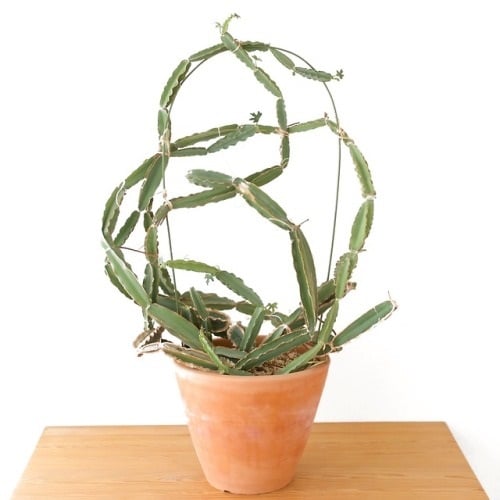Veldt Grape is widely popular for its exceptional medicinal benefits. Here’s everything on How to Grow Cissus quadrangularis Indoors.

Cissus quadrangularis is a low-maintenance houseplant known for its proven health benefits and beautiful appearance. For centuries, people have been using its stem extract for treating bone fractures, injuries, pain, and a wide variety of ailments. Growing, it is highly rewarding! Let’s have a look at How to Grow Cissus quadrangularis Indoors.
Botanical Name: Cissus quadrangularis
Other Names: Winged Treebine, Adamant Creeper, Devil’s Backbone, Hadjod, Harbhanga, Harishankar, Patah Tulang, Phet Cha Sung Khaat, Phet Sang Kat, Pirandai, Quadrangularis, Samroi To, San Cha Khuat, Stemmed Vine, Vajrangi, Veldt-grape, and Vitis quadrangularis
Check out our article on the best medicinal plants and their benefits here
Propagation and Pot Size
You can easily propagate the plant by cuttings. Take 4-6 inches of stem with several segments for the best results. You can also grow it from seeds. To save time, we highly recommend you to get a healthy plant from a nursery or a garden center.
Start a new plant in 4-6 inches of the pot. If you have bought the plant from a nursery, re-pot it in size bigger container. Ensure it has sufficient drainage holes as it promotes good aeration, keeping the plant healthy and thriving.
Requirements for Growing Cissus quadrangularis Indoors

Location
It is a sun-loving plant and grows remarkably well when it gets 4-5 hours of bright, direct sunlight every day. The plant can survive a shady location with an occasional bright light but prefer locations like a sunny windowsill, terrace, and balcony for growing this beautiful vine succulent.
Temperature
Being a heat-loving plant, Cissus quadrangularsis thrives well in the temperature range 50-90 F (10-32C) and does quite good in the room temperature. Move the plant outdoors during the summer months to encourage better growth. Remember to protect the plant during the harsh and frosty winter season.
Soil
Though the plant will do quite well in garden or houseplant soil, using a succulent potting mix with fast drainage and aeration makes for an excellent growing medium for this houseplant.
Watering
This is a drought-tolerant plant and doesn’t need regular watering, so it is better to water only when the topsoil completely dries out. Avoid overwatering, as it can lead to root rot and end up harming your plant. Make sure your pot has enough drainage holes to allow the excess water to drain out.
Cissus quadrangularis Care

Fertilizer
Feed this vine succulent once in 2 months with an all-purpose fertilizer. It will supply all the essential nutrients, encouraging good growth, and keeping the plant happy. Do check the label for dosage and instructions.
Pruning
Pruning the stems will promote the growth of numerous side branches that will make the plant appear fuller and lush. The period between late winter and summer is good for pruning and allows the plant to regrow actively.
Pests and Diseases
Pests like mealybugs and aphids pose a threat to Cissus quadrangularis. So it is wise to apply appropriate pesticides on early signs of infection and get rid of them in the first place. The plant is resistant to most of the diseases if taken care of properly.
Health Benefits and Medicinal Uses

For hundreds of years, Cissus quadrangularis has been part of Ayurveda, African, and Thai medicine culture for curing a wide range of diseases and symptoms. Below are some of its proven health benefits and uses.
- It is used as an herbal supplement for curing the symptoms of diabetes, obesity, hemorrhoids, and health-related diseases.
- According to this study, including the plant in the diet promotes good bone health by increasing the production of osteoblasts: cells responsible for forming new bones.
- The healing and anti-inflammatory properties of the plant provides relief from joint pain and arthritis.
- According to small research by the Journal of Alternative and Complementary Medicine, including herbal tea or supplement made from the stem of the plant helps in weight loss.


